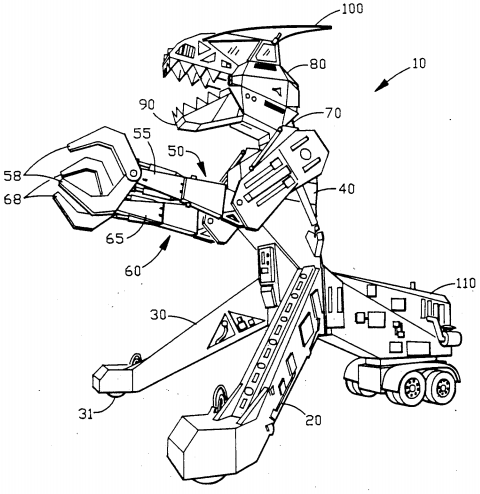
There are many sections of a patent document, which may vary slightly by country, but typically contain:
- an abstract,
- the background of the invention,
- a summary of the invention,
- a brief description of the drawings,
- a detailed description of the invention,
- drawings or figures,
- and the claims.
The claims are in many ways the most important part of your patent application because they determine what you can prevent others from using, selling, manufacturing and importing. The claims are the only enforceable part of the invention. If, once your patent application is accepted and becomes and issued patent, a competitor uses your invention, you only have legal recourse if they are using exactly what is written in one of your claims. If they leave one part of your claim out, for example, they wouldn’t be infringing on your invention and your patent wouldn’t help you stop the competitor from using their version of your idea. Let’s look at a specific example.
Narrow Claims
Let’s say you filed a patent on a “Trailerable robot for crushing vehicles”, and your first claim read something like this:
1. A trailerable robotic figure comprising a body and a tail mounted upon at least one pair of forward wheels and at least one pair of rear wheels, said body being hinged to said tail for movement of said body between an erect exhibition position and a lowered trailerable position wherein a portion of said body extends forwardly of said tail and includes attachment means for pivotal connection to a tractor for hauling said robotic figure over roads.
Let’s assume you ran a monster truck show but there were a bunch of competitor monster truck shows popping up in the area and they were all pulling your customers away with competitive giant robotic monsters that could eat cars. So you filed your patent with the above claim. Let’s say your patent issued pretty quickly, maybe only 2 or 3 years later, but it turned out that at that time none of your competitors’ robots had tails. Given that your claim explicitly requires a tail, anyone with a trailerable robotic figure with a hinge that allows movement between an exhibition position and a trailerable position but no tail is in the clear to use their invention.
Given this, and a few other issues with the claims of this patent, I would argue that the claims written in this patent are too narrow to be of significant value to the owner, at least in terms of excluding others from using this invention. In fact, an issued patent with this resulting claim might not have even been worth the costs associated with drafting, filing and maintaining this patent. It does however bring significant value to those of us looking for cool patent examples to write blog posts about, so thank you Monster Robot Inc.
Claim Rejection
The claim above as it was written may not have been the original first claim of Monster Robot’s patent application. The patent office may have rejected their initial patent application due to issues with novelty or obviousness (subscribe to our mailing list for a future post on this). Perhaps they needed to adjust or narrow their first claim so that at least some version of their patent would be accepted and would issue. The robot without the tail might have been rejected, but this was the first time anyone had invented a trailerable car crushing robot with a tail.
Broad Claims
If this was not the case, I would argue that they should have included additional broader claims in their initial application to attempt to get a stronger patent. For example, depending on the results of their assessment on the prior art for robot monsters (if they completed one), they might have tried:
1. A trailerable robotic figure mounted upon one or more wheels, having a forward portion hinged to a rear portion for movement of said forward portion between an erect exhibition position and a lowered trailerable position wherein said forward portion includes attachment means for pivotal connection to a tractor for hauling said robotic figure over roads.
or even better:
1. A trailerable robot capable of transitioning between an erect position and a lowered trailerable position.
Not having done an extensive assessment of these potential claims, it isn’t clear if these claims would have been rejected by the patent office. However, even if they had a high likelihood of rejection, there isn’t typically a big downside to also including these versions just in case they are accepted. Monster Robot could always still include the original version of their claim as claim number 2 or 3.
Related Inventions
Alternatively, or in addition to this patent, perhaps there were one or more parts of the broader invention that were completely new and innovative, such as the hinge specifically. Filing a patent on just this new hinge invention could have allowed Monster Robot Inc to prevent its competition from using such hinge anywhere in their robots, and could have led to numerous licensing opportunities in other industries outside Monster Robot’s core industry (stay in touch for more info about this in the future). For example, Monster Robot could have licensed the right to use their hinge patent to a large crane manufacturer, thereby bringing in side-revenue to help accelerate the growth of their giant car-destroying fire-breathing monster business.
Preparing for Better Patents
When I work with a client, I make sure I have a thorough and deep understanding of their technology. Prior to researching comparable prior art, I ask as many questions as is necessary to determine what patentable inventions might have been developed and what aspects in particular might be key components to assess for patentability. If existing patents or publications are found similar to one aspect of a client’s invention, I would typically advise that they focus the claims of their patent application on a different aspect that may have a higher likelihood of being accepted by the patent office. This way, not only do my clients gain a better understanding of the competitive landscape, prior art, and whether or not their invention might be accepted, they also end up with a better patent.
Oh and here’s a video of the US Patent 530890 in action – with a clear tail (keep watching, it grabs a car and starts ripping it apart a few minutes in):

